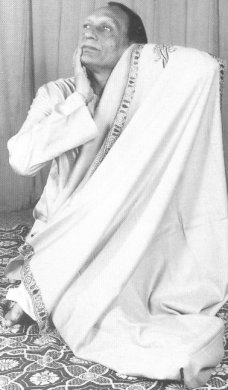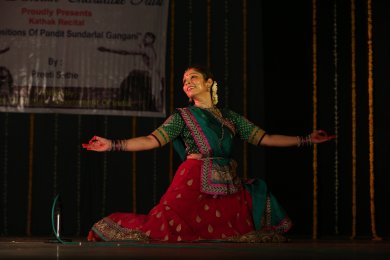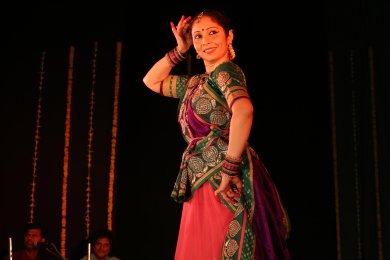
|   |

|   |
A befitting tribute to Pandit Sundarlal Gangani - Shyamhari Chakra e-mail: shyamhari@yahoo.com September 16, 2014 Although often referred to as the ‘Kathak Samrat’ of Baroda, late legendary Sundarlal Gangani was arguably, another ‘maharaja’ of Kathak. ‘Compositions of Pandit Sundarlal Gangani’, a unique event staged recently at the M.S. University of Baroda auditorium by the city-based Kathak Darshan Charitable Trust with financial support of the Ministry of Culture following his passing away in December last, was seen to be believed in the genius of this pioneering pandit.  Sundarlal Gangani
Sundarlal, who passed away at the age of 84, not only planted the seed of Kathak in the then state of Baroda, but also served the Department of Kathak of the University as its founder-professor for four decades. The multi-dimensional exponent of the Jaipur gharana was a guru-performer, poet, composer, musician, percussionist par excellence – all harmoniously blended into one. Born in Rajasthan but based in Gujarat, he has the rare distinction of being honoured by the Gujarat Sangeet Natak Akademi Award and Rajasthan Sangeet Natak Akademi Award besides the coveted Central Sangeet Natak Akadermi Award. His worthy sons and successors – Pandit Harish Gangani and Pandit Jagdish Gangani – are carrying forward their father’s legacy as professors of the Department. Jagdish has been the founder of the 19-year-old Kathak Darshan Charitable Trust that hosts a major annual Kathak festival featuring the stars and stalwarts. Preeti Sathe, a young faculty member of the Kathak department and disciple of Jagadish Gangani, who has earned reputation as a potential soloist, performed all the compositions in the two-hour concert. “My ‘dada guru’ (guru’s guru) was very concerned over the rapidly vanishing genre of solo dancing against the onslaught of group presentations. Therefore, my guru conceptualized this challenging solo concert showcasing all the compositions of his father to prove that solo dancing still can reign,” explained Preeti. As her guru had visualized, the captivating concert could retain the audience till the curtains came down around midnight. The concert, conducted by Jagdish Gangani with complete command – he also choreographed all the compositions of Sundarlal Gangani – had an amazing band of live orchestra that set the mood of the late evening. They were Bhupesh Gangani (tabla), Praveen Arya from Kathak Kendra, Jaipur (pakhawaj), Kaushik Varma (vocal and harmonium), Illiyaz Khan (sarangi) and Ajit Parmar (keyboard). Sundarlal, the intelligent poet-composer, has succeeded in incorporating the word ‘sundar’ (beauty) in most of his compositions and he has been the creator of the immensely popular “Sundar Kahat Kathak Katha” that we often come across in Kathak concerts. Preeti commenced her concert with this composition that tells the tale of Kathak besides being an invocation to the creator of dance. While the usual introductory footwork ‘tha’ denotes Lord Shiva, ‘thei’ referred to Goddess Parvati. Their union is the creation of this beautiful dance form. It was a beautiful exploration of the taal (rhythm) pattern elaborating the tandav ang and the lasya ang respectively. The next number Ek Brahma Urr Dhari Sundar was wizardry of words from this pioneering composer. It was the story of numbers from 1 to 16 and each with a philosophical interpretation like Ek Brahma, Do Nayan, Pancha Tatwa, Sapta Rishi, Ashta Nayika, Nava rasa, Shola Singara. 

Moving on, Preeti presented a bouquet of the traditional repertoire of Kathak – thaat, amad, paran, chalan, tukda, bandish and padasanchalan – giving glimpses into the grandeur of Jaipur gharana. Prior to the entry of the dancer, the solo rendition of the soul-stirring sarangi followed by the brilliant beats of the pakhawaj delineating the magical taal patters evoked thunderous applause from the audience. And, at this moment entered the dancer with 25 chakkars (spins) covering the entire expansive stage-space with effortless ease doubling the clapping. Her spectacular spins were not merely an exhibition of her stamina or body kinetic but an ecstatic expression of the joy of dancing. Never did the dancer go overboard to play to the gallery – footwork, spins, movements and expressions were quite measured. The beauty of this presentation was the coining of contrasts in the composition - the juxtaposition of the fast-paced with the lyrical footwork. After presenting the distinctly different pure dance numbers for which Sundarlal Gangani was famous, it was the turn for Preeti to offer us a peep into her dada guru’s creations of expressional dance. Eri Guiya was a simple and beautiful narration of the conversation between two sakhis about the seductive charm of Krishna’s flute. Ashtanayika, the next presentation, was beautiful for its brevity. The moods and sentiments of each of the eight nayikas were shown in quick succession and yet convincingly conveying the distinct differences in their characters. Though Tero Aadhar that followed was a devotional number that delineated how the Lord of the Universe has been the creator of everything beautiful as Kathak, it lucidly explained the idioms of Kathak based on different laya and taal that Preeti could perfectly portray in her footwork. Similarly, Karat Sola Shringar – in which a lady decorates herself to look beautiful – aptly highlighted the elements of aharya abhinaya in portrayal of the abhisarika nayika. The fitting finale to the concert was the dance of ecstasy in the drut laya with kavitt, gat bhav and chalan. As Preeti received a standing ovation from the enlightened audience that included Rajmata Shubhanginiraje Gaekwad who represented the great arts-patron royal rulers of the erstwhile State of Baroda, Kathak exponents Pandit Hiralal Hasal and Pandit Bhimashankar from Mumbai and Vice Chancellor of the University Professor Yogesh Singh, Sundarlal Gangani must have smiled from the heavens – for it was the solo dancing genre that finally won over the connoisseurs! A former journalist with Indian Express and The Hindu for 20 years in Bhubaneswar covering culture, Shyamhari Chakra is presently based at New Delhi as an independent dance writer. |